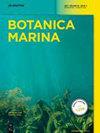Grazing of free-living Pylaiella littoralis by the amphipod Gammarus tigrinus
IF 1.4
4区 生物学
Q2 MARINE & FRESHWATER BIOLOGY
引用次数: 0
Abstract
片脚类动物啃食自由生活的滨海木虱
滨海褐藻(Pylaiella littoralis)是一种分布于世界各地的褐色藻类。美国马萨诸塞州纳汉特海滩上有一种自由生活的藻类。在漂浮的藻类中发现了片脚类动物 Gammarus tigrinus。肠道内容物证实 G. tigrinus 食用了 P. littoralis。值得注意的是,培养研究表明,摄入的滨海栉水母能从虎纹蛙产生的粪便颗粒中存活和生长。此外,低效放牧产生的无性碎片也能生长和存活。片脚类动物和滨虫的δ 13C 值平均值分别为-17.4 ‰和-17.7 ‰,这表明虎纹蛙的大部分碳来自滨虫。
本文章由计算机程序翻译,如有差异,请以英文原文为准。
求助全文
约1分钟内获得全文
求助全文
来源期刊

Botanica Marina
生物-海洋与淡水生物学
CiteScore
4.10
自引率
4.50%
发文量
43
期刊介绍:
Botanica Marina publishes high-quality contributions from all of the disciplines of marine botany at all levels of biological organisation from subcellular to ecosystem: chemistry and applications, genomics, physiology and ecology, phylogeny and biogeography. Research involving global or interdisciplinary interest is especially welcome. Applied science papers are appreciated, particularly when they illustrate the application of emerging conceptual issues or promote developing technologies. The journal invites state-of-the art reviews dealing with recent developments in marine botany.
 求助内容:
求助内容: 应助结果提醒方式:
应助结果提醒方式:


